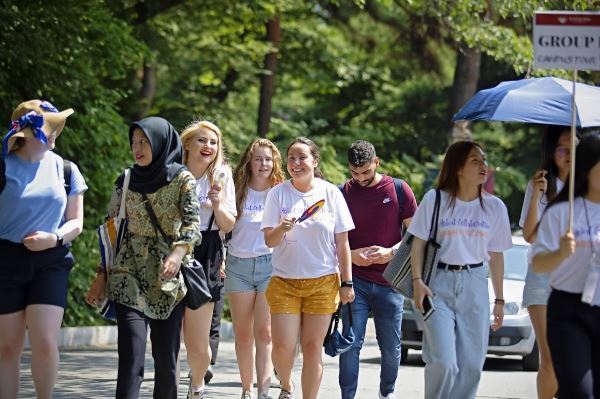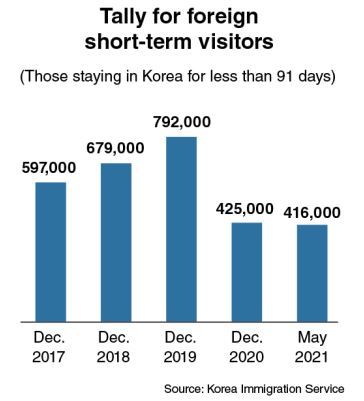[News Focus] Number of short-term foreign visitors falls to 63-month low
Tally of foreign students shows meager growth on-year
By Kim Yon-sePublished : July 18, 2021 - 12:55

SEJONG -- The number of short-term foreign visitors to South Korea has fallen to its lowest in more than five years in the aftermath of the novel coronavirus, data from a state-run agency showed.
This refers to foreign nationals, including ethnic Koreans, with permission to stay in Korea for no more than 90 days for sightseeing, business or other purposes.
According to the Korea Immigration Service, the number of short-term visitors recorded 416,817 in May, as compared with 417,883 a month earlier and 456,157 a year earlier. The May 2021 figure marked the lowest on a monthly basis since COVID-19 hit the nation in January 2020.
It was also the lowest figure in 63 months since February 2016, when 395,050 people were in Korea as short-term visitors.
Compared with the record-high of 792,853 in December 2019, the recent figure had dropped 47.4 percent.

Previously, the number of short-term inbound visitors had shown a continual increase -- from 258,673 at the end of 2010 to 356,842 at the end of 2013, 518,902 at the end of 2016 and 792,853 at the end of 2019.
Though there were hopes for its recovery earlier this year, the number of new COVID-19 infections on a daily basis is seeing all-time highs in July and a pessimistic outlook is looming.
In the same vein, the tally of long-term visitors -- that is, foreigners staying in the nation for 91 days or longer -- slid to 1.56 million in May, in contrast with 1.73 million at the end of 2019 and 1.68 million at the end of 2018.
Of the 1.98 million foreigners who were staying in Korea for either short- or long-term sojourns as of May, Chinese nationals still made up the greatest portion of the total at 861,526 people.
But that figure represents a 21.8 percent decline from the 1.101 million posted in December 2019. Chinese citizens of Korean descent made up more than 72.3 percent (622,935) of the 861,526 Chinese here.
Vietnamese and Thais were the next most numerous, respectively accounting for 209,121 and 175,547 people. Many were laborers or spouses of Korean nationals who had arrived before the pandemic, while others chose to visit despite COVID-19.
Fourth were US nationals at 148,211 people, including about 28,500 US military troops stationed here. There were also 64,656 Uzbeks, 48,681 Russians, 48,162 Philippine nationals, 40,062 Mongolians and 37,217 Nepalese.
Next were Indonesians at 34,899, Kazakhs at 30,104, Japanese at 27,764, Myanmar nationals at 25,302 and Canadians at 21,792. Australians numbered 7,554 and UK nationals 5,662.
Those in their 30s accounted for the largest proportion of foreigners in Korea at 27.7 percent (550,202 people), followed by those in their 20s at 21.3 percent (423,055), those in their 40s at 16.8 percent (334,106) and those in their 50s at 15.2 percent (302,822).
Meanwhile, the immigration data showed that the number of foreigners studying in Korea had inched up 3.4 percent on-year to 158,752 as of May.
While the tally of foreign students at local colleges and other schools increased from 101,486 in May 2020 to 109,796 in May 2021, the number of people staying here to learn the Korean language fell from 52,027 to 48,949.


![[Exclusive] Korean military set to ban iPhones over 'security' concerns](http://res.heraldm.com/phpwas/restmb_idxmake.php?idx=644&simg=/content/image/2024/04/23/20240423050599_0.jpg&u=20240423183955)




![[Herald Interview] 'Amid aging population, Korea to invite more young professionals from overseas'](http://res.heraldm.com/phpwas/restmb_idxmake.php?idx=644&simg=/content/image/2024/04/24/20240424050844_0.jpg&u=20240424200058)
![[Pressure points] Leggings in public: Fashion statement or social faux pas?](http://res.heraldm.com/phpwas/restmb_idxmake.php?idx=644&simg=/content/image/2024/04/23/20240423050669_0.jpg&u=)









